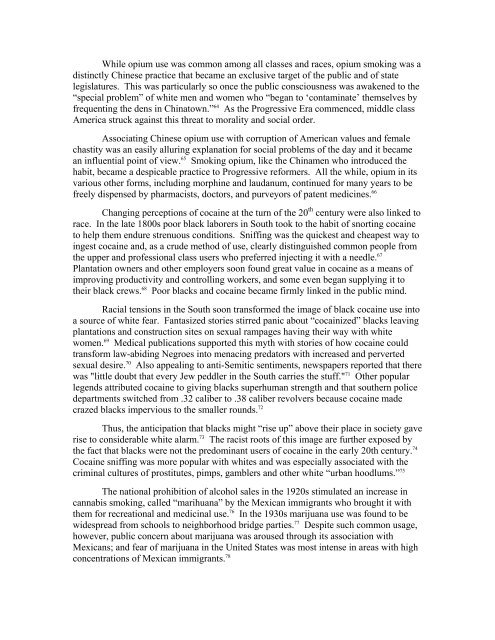Effective Drug Control: Toward A New Legal Framework
Effective Drug Control: Toward A New Legal Framework
Effective Drug Control: Toward A New Legal Framework
You also want an ePaper? Increase the reach of your titles
YUMPU automatically turns print PDFs into web optimized ePapers that Google loves.
While opium use was common among all classes and races, opium smoking was a<br />
distinctly Chinese practice that became an exclusive target of the public and of state<br />
legislatures. This was particularly so once the public consciousness was awakened to the<br />
“special problem” of white men and women who “began to ‘contaminate’ themselves by<br />
frequenting the dens in Chinatown.” 64 As the Progressive Era commenced, middle class<br />
America struck against this threat to morality and social order.<br />
Associating Chinese opium use with corruption of American values and female<br />
chastity was an easily alluring explanation for social problems of the day and it became<br />
an influential point of view. 65 Smoking opium, like the Chinamen who introduced the<br />
habit, became a despicable practice to Progressive reformers. All the while, opium in its<br />
various other forms, including morphine and laudanum, continued for many years to be<br />
freely dispensed by pharmacists, doctors, and purveyors of patent medicines. 66<br />
Changing perceptions of cocaine at the turn of the 20 th century were also linked to<br />
race. In the late 1800s poor black laborers in South took to the habit of snorting cocaine<br />
to help them endure strenuous conditions. Sniffing was the quickest and cheapest way to<br />
ingest cocaine and, as a crude method of use, clearly distinguished common people from<br />
the upper and professional class users who preferred injecting it with a needle. 67<br />
Plantation owners and other employers soon found great value in cocaine as a means of<br />
improving productivity and controlling workers, and some even began supplying it to<br />
their black crews. 68 Poor blacks and cocaine became firmly linked in the public mind.<br />
Racial tensions in the South soon transformed the image of black cocaine use into<br />
a source of white fear. Fantasized stories stirred panic about “cocainized” blacks leaving<br />
plantations and construction sites on sexual rampages having their way with white<br />
women. 69 Medical publications supported this myth with stories of how cocaine could<br />
transform law-abiding Negroes into menacing predators with increased and perverted<br />
sexual desire. 70 Also appealing to anti-Semitic sentiments, newspapers reported that there<br />
was "little doubt that every Jew peddler in the South carries the stuff." 71 Other popular<br />
legends attributed cocaine to giving blacks superhuman strength and that southern police<br />
departments switched from .32 caliber to .38 caliber revolvers because cocaine made<br />
crazed blacks impervious to the smaller rounds. 72<br />
Thus, the anticipation that blacks might “rise up” above their place in society gave<br />
rise to considerable white alarm. 73 The racist roots of this image are further exposed by<br />
the fact that blacks were not the predominant users of cocaine in the early 20th century. 74<br />
Cocaine sniffing was more popular with whites and was especially associated with the<br />
criminal cultures of prostitutes, pimps, gamblers and other white “urban hoodlums.” 75<br />
The national prohibition of alcohol sales in the 1920s stimulated an increase in<br />
cannabis smoking, called “marihuana” by the Mexican immigrants who brought it with<br />
them for recreational and medicinal use. 76 In the 1930s marijuana use was found to be<br />
widespread from schools to neighborhood bridge parties. 77 Despite such common usage,<br />
however, public concern about marijuana was aroused through its association with<br />
Mexicans; and fear of marijuana in the United States was most intense in areas with high<br />
concentrations of Mexican immigrants. 78
















